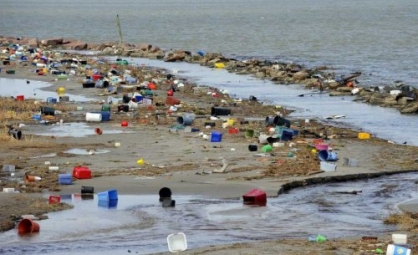Pacific Ocean or Plastic Soup, You decide?
Imagine a lovely beach vacation; soaking in the sun, when a big wave crashes on the sand and something seems different about this simple rhythmic pattern. The once angelic views of the soft sand is now covered with plastic debris of all shapes and sizes. Not exactly a LUXified adventure! ![]()
You might think I am simply describing a ‘what if, worst case’ scenario, but unfortunately in many of our beaches around the world this is becoming more and more a common phenomenon.
Did you know that the one of the biggest areas of accumulated plastic debris is in the middle of the Pacific Ocean, referred to as the North Pacific Gyre (NPG)? A gyre is described as a vortex of ocean currents that form a swirling pattern and the NPG is located between Hawaii and California. As of today, it is estimated to have 3.5 million tons of plastic debris! Outrageous right??. This is an unforeseen killer in the middle of our ocean and most people are completely unaware of that the problem even exists, much less know of its devastating side effects. At this point, they estimate the size of the NPG to be roughly twice the size of the United States. It has two ‘garbage patches’ about the size of Texas that is created by these wind and ocean currents: The Eastern patch is about 500 miles off the coast of California and a Western patch about 200 miles off the coast of Japan.
So where does all this plastic come from? You might be surprised to know that approximately, 80% of plastic debris is identified to come from land based sources, according to The United Nations Joint Group of Experts on the Scientific Aspects of Marine Pollution (GESAMP). That means the majority of the problem stems from the littering of beaches, of our storm drains and from some natural disasters. Making it even more crucial to not only care for your own trash, but to pick up any that you might see in any of these places. Our oceans thank you in advance!! ![]() To find out more about this growing problem, watch this TED video of Charles Moore, the founder of Algalita Foundation, a nonprofit organization leading the research of this growing plastic problem.
To find out more about this growing problem, watch this TED video of Charles Moore, the founder of Algalita Foundation, a nonprofit organization leading the research of this growing plastic problem.
The Stats: Most recently, plastic outweighed plankton pieces 6:1. This is translated to mean that for every pound of plankton (common sea life ‘sushi’), there are six pounds of plastic to match!?! You could only imagine the type of damage that this is causing to our ecosystem and aquaculture. Not to mention, that petroleum-based plastic is photo-degradable, which means it keeps breaking down into smaller and smaller pieces, but never really completely disappears. On top of it all LUXies, the plastic trash continues to attract other deadly chemicals, such as Polycholorinated biphenyls (PCBs) and DDE, a degraded form of the pesticide DDT. This then causes it to become even more toxic when digested and has even been known as ‘endocrine-disruptors’. These digested chemicals then work there way up the food chain and kills many birds, turtles, and fish in the process, due to the “mistaken” plastic food. To find out more about the toxins in plastic, explore ‘The Petrochemical Tree.’
“We should be very concerned,” says Theo Colborn, founder of The Endocrine Disruption Exchange (TEDX), a U.S.- based organization that focuses on the health effects of endocrine-disrupting chemicals. Though these health effects are still the topic of much debate, she says a host of scientific studies have shown that even low-level exposure to endocrine disrupters may be linked to attention- deficit disorder, diabetes, falling fertility rates and more.
As of today, there is one not for profit organization geared at addressing the clean up aspect of this growing epidemic, the Environmental Cleanup Coalition (ECC) . There aim is to build a community to attract people across disciplines, industries, specialties, and countries to set aside their differences and pull together to address the largest cleanup effort in history. Do check them out! We would like to advocate anyone who is willing to take such courageous action towards such an un-surmounting problem!!
For more information, please reference the Algalita Foundation, Watch the TED video of Charles Moore, Great Garbage Patch Organization and read the article within Science Direct.
Tagged in: ted, charles moore, algalita foundation, ecc, science direct, environmental cleanup coalition, tedx, plastic pollution, north pacific gyre npg, gesamp, plastic soup, great garbage patch organization, the petrochemical tree, plastic ocean, trash debris,




